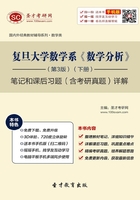
12.2 课后习题详解
§1 富里埃级数
1.证明:
(1)1,cosx,cos2x,…,cosnx,…
(2)sinx,sin2x,sin3x,…,sinnx,…
是[0,π]上的正交系;但1,cosx,sinx,cos2x,sin2x,…,cosnx,sinnx,…不是[0,π]上的正交系.
证明:(1)因


则1,cosx,cos2x,…,cosnx,…是[0,π]上的正交系
(2)因
则sinx,sin2x,sin3x,…,sinnx,…是[0,π]上的正交系
又 则1,cosx,cos2x,sin2x,…cosnx,sinnx,…不是[0,π]上的正交系.
则1,cosx,cos2x,sin2x,…cosnx,sinnx,…不是[0,π]上的正交系.
2.证明:sinx,sin3x,…sin(2n+1)x,…是 上的正交系,写出它的标准正交系
上的正交系,写出它的标准正交系
(即不仅正交,而且每个函数的平方在 上的积分为1),并导出
上的积分为1),并导出

是[0,1]上的正交系.
证明:因
则sinx,sin3x,…sin(2n+1)x,…是 上的正交系
上的正交系
又由 得
得
则在 上它的标准正交系为
上它的标准正交系为
又
则 是[0,l]上的正交系.
是[0,l]上的正交系.
3.设f(t)是周期为2π的方波,它在[﹣π,π]上的函数表示式为

将这个方波展开成傅里叶级数.
解:因 又
又

则


则

4.设f(t)是周期为T的半波整流波,它在 上的函数表示式为
上的函数表示式为

将这半波整流波展开成傅里叶级数.
解:因
则

则

5.设f(t)以2π为周期,在[-π,π]内

把f(t)展开成傅里叶级数.
解:因


6.设f(t)是周期为2π、高为h的锯齿形波,它在[0,2π]上的函数表示式为 ,将这个锯齿形波展开成傅里叶级数.
,将这个锯齿形波展开成傅里叶级数.
解:因

则
7.将宽度为τ、高为h、周期为T的矩形波展开成余弦级数.
解:在一个周期 内矩形波函数表达式为
内矩形波函数表达式为

则

8.写出如图12-1所示的周期为T的三角波在 内的函数表达式,并将它展开成正弦级数.
内的函数表达式,并将它展开成正弦级数.

图12-1
解:如图所示的周期为T的三角波在 的函数表达式为
的函数表达式为

先把f(t)延拓成 上的函数,再据题意,还必须把它延拓成奇函数,于是a0=ak=0
上的函数,再据题意,还必须把它延拓成奇函数,于是a0=ak=0

则
9.将f(x)=sgn(cosx)展开成傅里叶级数.
解:因f(x+2π)=sgn[cos(x+2π)]=sgn(cosx)=f(x),则f(x)是以2π为周期的周期函数
又

则f(x)在(-∞,+∞)上可展为

10.应当如何把区间 内的可积函数f(x)延拓后,使它展开成的傅里叶级数的性状如下:
内的可积函数f(x)延拓后,使它展开成的傅里叶级数的性状如下:

解:因展开式中无正弦项,则f(x)延拓后应为偶函数
设f(x)延拓到 内的部分为φ(x)
内的部分为φ(x)
因展开式中偶数项的系数a2n=0即

则
在左端前一积分中作变量代换,令x=π-t则

要使上式成立,则必须当 时.有f(π-x)+φ(x)=0即φ(x)=-f(π-x)
时.有f(π-x)+φ(x)=0即φ(x)=-f(π-x)
于是就求出了延拓后的函数在 内的表达式为-f(π-x)
内的表达式为-f(π-x)
又延拓后的函数为偶函数,则它在 的表达式为f(-x),在
的表达式为f(-x),在 的表达式为-f(π+x)
的表达式为-f(π+x)
不妨设延拓后的函数为ψ(x),则

11.同上一题,但展开的傅里叶级数形状为:

解:因展开式中无余弦项,则f(x)延拓后应为奇函数
设f(x)延拓到 内的部分为φ(x)
内的部分为φ(x)
因展开式中偶数项的系数b2n=0即

则 
在左端前一积分中作变量代换,令x=π-t
则
要使上式成立,则必须当 时.有-f(π-x)+φ(x)=0即φ(x)=f(π-x)
时.有-f(π-x)+φ(x)=0即φ(x)=f(π-x)
于是就求出了延拓后的函数在 内的表达式为f(π-x)
内的表达式为f(π-x)
又延拓后的函数为奇函数,则它在 的表达式为-f(-x),在
的表达式为-f(-x),在 上的表达式为-f(π+x)
上的表达式为-f(π+x)
不妨设延拓后的函数为ψ(x),则

12.设f(x)可积、绝对可积,证明:
(1)如果函数f(x)在[-π,π]上满足f(x+π)=f(x),那么a2m-1=b2m-1=0
(2)如果函数f(x)在[-π,π]上满足f(x+π)= -f(x),那么a2m=b2m=0
证明:(1)因f(x)可积、绝对可积且函数f(x)在[-π,π]上满足f(x+π)=f(x)
则f(x)在[-π,π]上可积、绝对可积且以π为周期
于是
对右端第二式作变量代换:t=x-π,则其变为

于是
从而,得a2m-1=0(m=1,2,…)
同理,得b2m-1=0(m=1,2,…)
(2)因f(x)可积、绝对可积且函数f(x)在[-π,π]上满足f(x+π)= -f(x),则f(x+2π)=f(x)
于是f(x)在[-π,π]上可积、绝对可积且以2π为周期
于是
对右端第二式作变量代换:t=x-π,则其变为

于是
从而,得a2m=0(m=1,2,…)
同理,得b2m=0(m=1,2,…)
13.如果 ,问φ(x)与
,问φ(x)与 的傅里叶系数之间有什么关系?
的傅里叶系数之间有什么关系?
解:函数φ(x)与 的傅里叶分为
的傅里叶分为

对 右端作变量代换y=-x,并将
右端作变量代换y=-x,并将 代入,得
代入,得

同理,得bn=-βn(n=1,2,…)
14.如果 ,问φ(x)与
,问φ(x)与 的傅里叶系数之间有什么关系?
的傅里叶系数之间有什么关系?
解:函数φ(x)与 的傅里叶系数分为
的傅里叶系数分为


对 右端作变量代换y=-x,并将
右端作变量代换y=-x,并将 代入,得
代入,得

同理,得bn=βn(n=1,2,…)
15.设f(t)在(-π,π)上分段连续,当t=0连续且有单侧导数,证明当p→∞时

证明:

在右端前一积分中令t=-x,则

代回原式,得


下证
因
对于
因f(t)在(-π,π)上分段连续, 在(δ,π)上连续,则
在(δ,π)上连续,则 在(δ,π)上分段连续因而可积,则由黎曼引理,得
在(δ,π)上分段连续因而可积,则由黎曼引理,得
对于

因 补充定义,t=0时,函数
补充定义,t=0时,函数 的值为0,则
的值为0,则 是[0,δ]上的连续函数
是[0,δ]上的连续函数
又f(t)为(-π,π)上的分段连续函数,则 在[0,δ]上分段连续,因而可积,则由黎曼引理,得
在[0,δ]上分段连续,因而可积,则由黎曼引理,得
因f'(+0),f''(-0)存在,则 存在
存在
补充定义,t=0时,函数 值为f'(+0)+f'(-0),则
值为f'(+0)+f'(-0),则 是[0,δ]上的分段函数,因而可积,于是由黎曼引理,得
是[0,δ]上的分段函数,因而可积,于是由黎曼引理,得
综上可得,当p→∞时,
§2 傅里叶变换
1.设f(x)在(-∞,+∞)内绝对可积,证明 在(-∞,+∞)内连续.
在(-∞,+∞)内连续.
证明:对 总有A',A'',使得ω∈[A',A'']
总有A',A'',使得ω∈[A',A'']
由于
后者收敛且不含参量ω,这表明积分 在[A',A'']上一致收敛,据一致收敛积分的连续性,得
在[A',A'']上一致收敛,据一致收敛积分的连续性,得 在[A',A'']上连续,从而在点ω处连续,由ω的任意性,得
在[A',A'']上连续,从而在点ω处连续,由ω的任意性,得 在(-∞,+∞)内连续.
在(-∞,+∞)内连续.
2.设f(x)在(-∞,+∞)内绝对可积,证明
证明:由f(x)在(-∞,+∞)内绝对可积,得对于任给的ε>0,存在A>0,使有

设f(x)在[0,A]内无暇点,则在[0,A]中插入分点0=t0<t1<…<tm=A,并设f(x)在[tk-1,tk]上的下确界为mk,于是

从而

其中ωk为f(x)在区间[tk-1,tk]上的振幅,△tk=tk-tk-1
由于f(x)在[0,A]上可积,故可取某一方法,使有
对于这样固定的方法, 为一定值,因而存在δ>0,使当ω>δ时,恒有
为一定值,因而存在δ>0,使当ω>δ时,恒有
于是对上述所选取的δ,当ω>δ时

其次,设f(x)在区间[0,A]中有瑕点,为简便起见,不妨设只有一个瑕点且为0,于是对任给的ε>0,存在η>0,使有
又f(x)在[η,A]上无瑕点,故应用上述结果可得存在δ,使当ω>δ时,恒有 于是当ω>δ时,有
于是当ω>δ时,有

即
同法,得当f(x)在(-∞,+∞)内绝对可积时,均有
同法可证得当f(x)在(-∞,+∞)内绝对可积时,
于是
3.求下列函数的傅里叶变换:
(1)

(2)

解:(1)

因 为(-∞,+∞)内的连续函数,则
为(-∞,+∞)内的连续函数,则
(2)


因 为(-∞,+∞)内的连续函数,则
为(-∞,+∞)内的连续函数,则